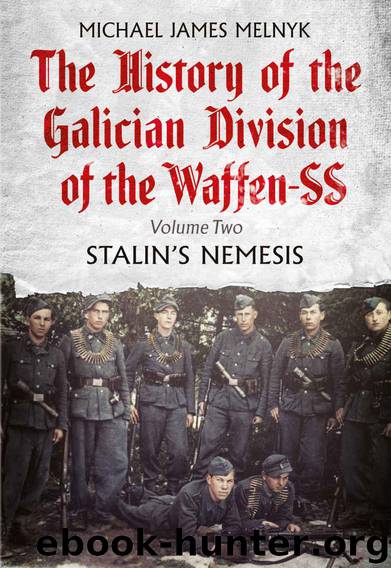Stalin's Nemesis by Michael James Melnyk

Author:Michael James Melnyk
Language: eng
Format: azw3
ISBN: 9781781555385
Publisher: Fonthill Media
Published: 2017-05-25T04:00:00+00:00
Stradner Kögel
Elsewhere, directly to the south, the heaviest fighting occurred around Stradner Kögel and the plateau which was 1,000 metres south of the elevation, where a series of attacks and counter-attacks in quick succession resulted in a fluid front line over the course of the next ten days and the unavoidable close quarter combat.282 As fighting took place both during the day and night, the sequential relief of the Division’s first echelon infantry units was instituted for the purpose of involving the forces more fully in combat acclimatisation.
In this sector WGR 30 occupied a precarious line in hastily constructed, over extended positions against which, the 20 Guards Rifle Division committed two of its regiments (60 Guards Rifle Regiment and 57 Guards Rifle Regiment) whose first probing attacks quickly forced a retreat of the regiments most advanced position near Kolldorf and Hochstraden.283
At this time WGR 31 arrived having completed its forced march from Slovenia.284 Waffen-Untersturmführer Volodymyr Mykula who commanded a platoon in the 2./I./WGR 31 recorded in his diary:
The march to the front started on 1 April 1945. First, there was a joint regimental Holy Mass in the area of Trebnje, about 80 km S/E of Ljubljana, on the River Krka. Then exercises were announced and the march started. In the night of 2/3 April the regiment marched through Ljubljana and arrived at Trnjava, where it rested for a day on the 4 of April having covered 130 km. The march continued for another 120 km non-stop passing through Celje in the night of the 5/6 April and Maribor early in the morning of 6 April. It then turned north to Sentilj, then headed east crossing the River Mur by bridge in the night of the 6/7 and passed through the town of Mureck. Turning north, it arrived at Straden on 7 April and took up positions on the eastern outreaches of the elongated forested mountain, Stradner Kögel before sunset.285
Although the original intention had been to keep WGR 31 in reserve, because of the casualties already sustained by WGR 30, it was necessary to move the regiment into the front immediately without rest or respite. Company commander Waffen-Untersturmführer Roman Herasymowych:
[…] On 7 April 1945, Red Army units started probing our positions—artillery and infantry activities (on this day 1./I./WGR 30 suffered two casualties). During the night of the 7 April 1945, 1./I./WGR 30 was relieved by WGR 31. A full battalion took up the positions of the 1 company. I./WGR 30 was relocated back (west) to the village of Stallhans as Divisional reserve .…]286
The next day, there was a full scale assault on the Ukrainian positions by the 61 Guards Rifle Division. The Division’s command re-committed elements of WRG 30 and with limited artillery support initially its infantry units held fast. Amidst shouts in Russian of ‘Prepare to attack!’ and ‘Hurrah!’ the Ukrainian battle cry of ‘Slava’ (Glory!) could be heard as both sides locked in close combat, however despite the courageous efforts of individuals such as Waffen-Untersturmführer Philip Trotch (14./WGR 30), whose personal bravery won him Iron Cross II.
Download
This site does not store any files on its server. We only index and link to content provided by other sites. Please contact the content providers to delete copyright contents if any and email us, we'll remove relevant links or contents immediately.
Shoot Sexy by Ryan Armbrust(17564)
Portrait Mastery in Black & White: Learn the Signature Style of a Legendary Photographer by Tim Kelly(16877)
Adobe Camera Raw For Digital Photographers Only by Rob Sheppard(16805)
Photographically Speaking: A Deeper Look at Creating Stronger Images (Eva Spring's Library) by David duChemin(16504)
Bombshells: Glamour Girls of a Lifetime by Sullivan Steve(13701)
Art Nude Photography Explained: How to Photograph and Understand Great Art Nude Images by Simon Walden(12858)
Perfect Rhythm by Jae(5080)
Pillow Thoughts by Courtney Peppernell(4031)
The Book of Joy by Dalai Lama(3710)
Good by S. Walden(3360)
The Pixar Touch by David A. Price(3225)
A Dictionary of Sociology by Unknown(2862)
Fantastic Beasts: The Crimes of Grindelwald by J. K. Rowling(2853)
Stacked Decks by The Rotenberg Collection(2699)
Humans of New York by Brandon Stanton(2694)
Read This If You Want to Take Great Photographs by Carroll Henry(2609)
On Photography by Susan Sontag(2494)
Photographic Guide to the Birds of Indonesia by Strange Morten;(2412)
Insomniac City by Bill Hayes(2404)
